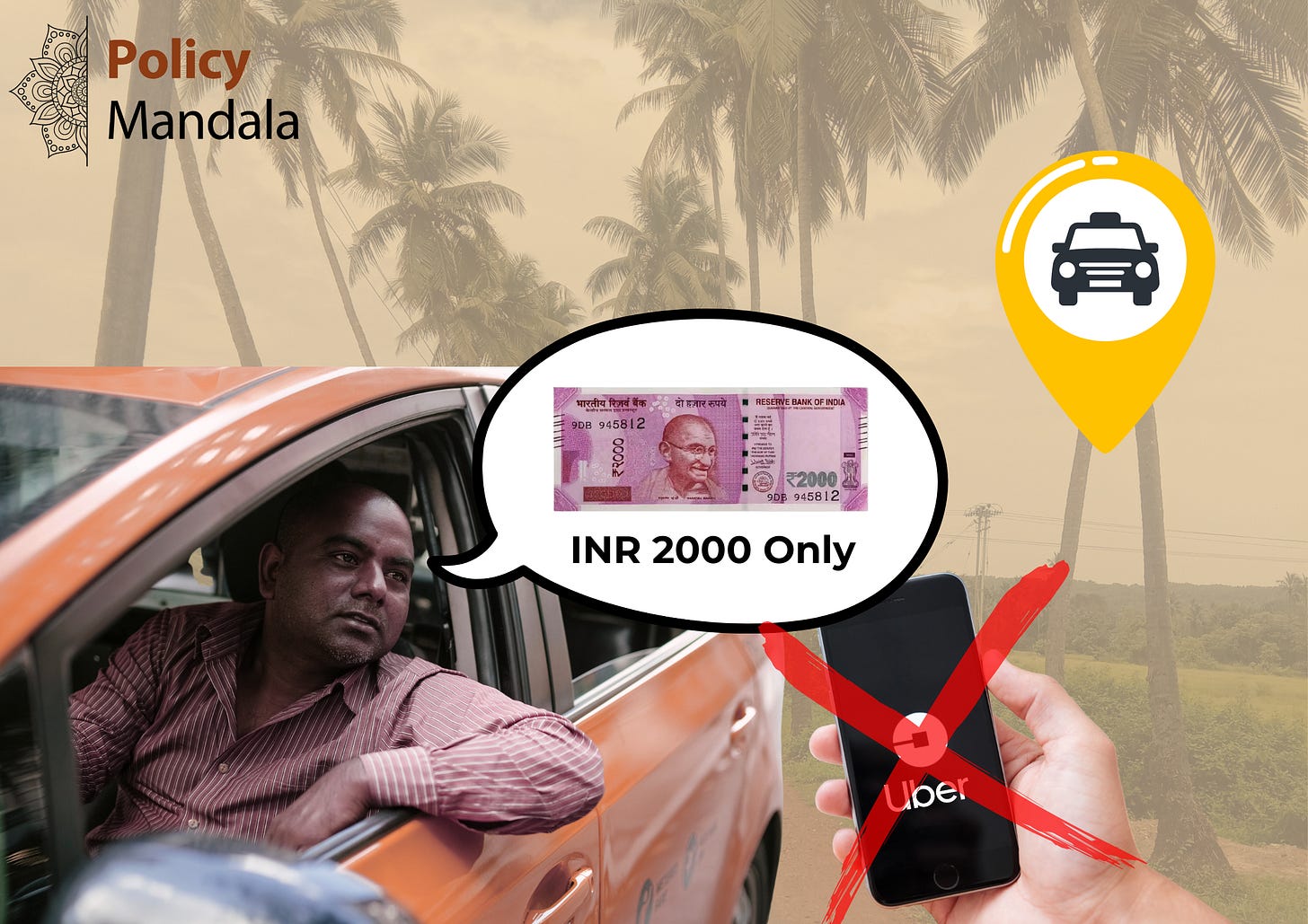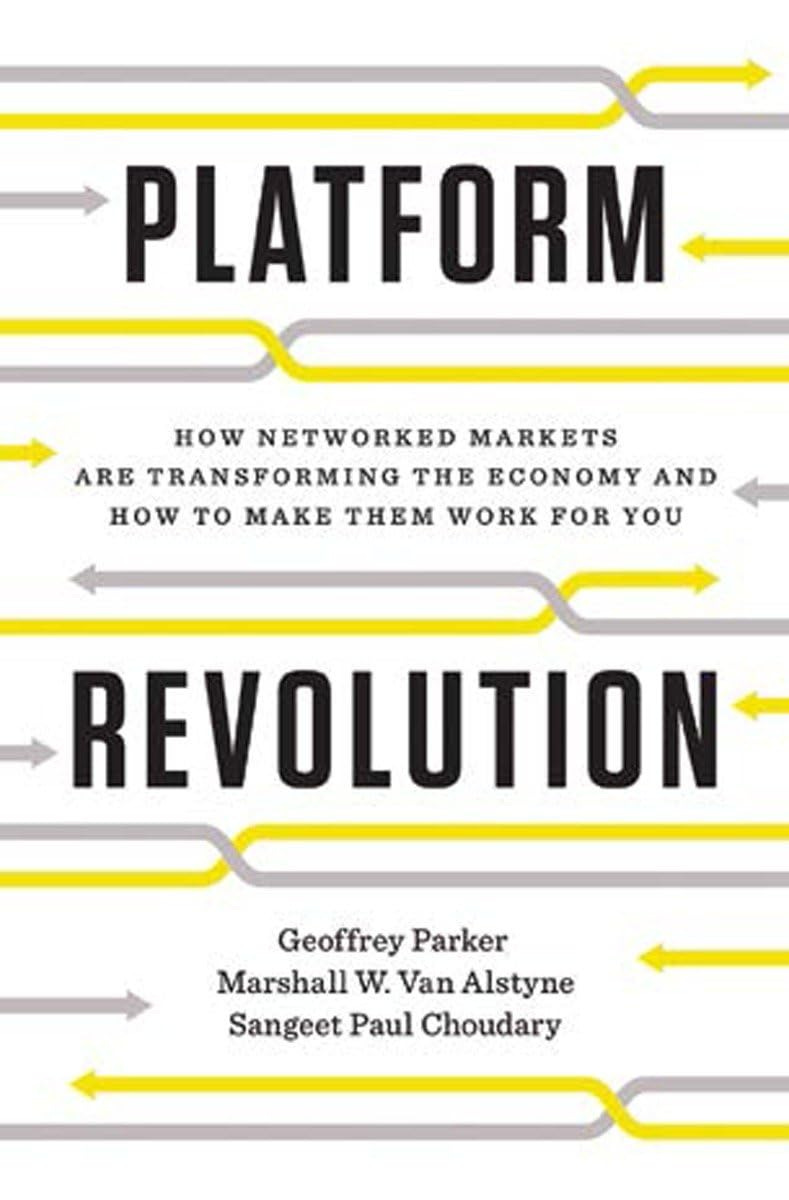#34 Why You Can’t Get an Uber in Goa (and Why That Matters): Goa’s Gamble with Platform Policy
Welcome to the 34th Policy Mandala by India House. This week, we explore Goa’s taxi rules—and what they reveal about how states trade convenience for control. Enjoy reading!
You’re standing at the Dabolim airport exit, bags in hand, in vacation mode and eager to visit the beach. With the sea just 40 minutes away, you can almost hear the waves and feel the sand already.
A driver approaches and quotes ₹2,500 for the ride to Calangute, barely 30 km away. You hesitate. Instinctively, you reach for your phone. No Uber. No Ola. Just the realisation that the services you rely on every day simply don’t work here, because Goa has made a different choice.
A choice made by Goa almost a decade ago: to keep national aggregators out. While the rest of India books nearly a thousand cabs each minute, Goa has kept major platforms at bay. Locals and tourists are left to rely on what taxi drivers quote, with little to no room for negotiation or alternatives.
This choice by Goa forces us to ask: What has Goa prioritized? Local electoral calculus or strategic economic preservation?
But wait, why are we discussing Goa? Why taxis? And why is this in Policy Mandala?
Because earlier this month, the state introduced the Goa Transport Aggregator Guidelines 2025: arguably one of the clearest signals yet of how India might regulate its platform economy when it conflicts with the local economy.
Let’s understand the context first. App-based taxis have been a key tourist demand in Goa for over a decade. If the recent protests by taxi unions over the new regulations are any indication, avoiding these platforms has also been a long-standing political stance of Goa’s taxi groups.
Let’s first unpack the Goa guidelines.
The new rules allow local aggregators to function in Goa while mandating a zero-commission model, fixed minimum fares, mandatory health insurance of ₹10 lakh for drivers (even more for women), a 48-hour grievance redressal system, and EV adoption incentives. Platforms must maintain a physical office in Goa and deposit ₹10 lakh as security.
These rules are still awaiting formal enforcement. But if implemented, they would make Goa one of the most driver-friendly states in India when it comes to cab aggregator rules. Sounds great, right?
Here’s the twist: these rules don’t apply to Ola or Uber, because they’re not allowed to operate in Goa at all. Chief Minister Pramod Sawant has made it clear: national aggregators are not welcome.
So why draft detailed regulations that don’t even apply to the largest players?
It’s political math. Goa has around 24,000 taxi drivers. Add their families and friends, and you have roughly 1.5 lakh voters in a state of 12 lakh. That’s over 12% of the electorate. Enough to sway elections. Enough to shape policy. Tourists bring revenue, but not votes. Taxi unions do, and they hold real sway in Goan elections.
But what explains this intense opposition to national aggregators like Ola and Uber?
In a democracy, three things matter to any government: votes, revenues, and survival. If the government supports the unions, it secures the votes. If it charges high licence fees from cabs, it fills the state coffers. And any disruption to the status quo makes things risky.
That’s why local platforms like Goa Miles thrive. It’s a government-backed platform operated by Goa locals, charges zero commission, and reportedly completes over 15,000 rides a day.
Yet tourists complain. Fares in Goa are among the highest in India: ₹36/km for hatchbacks, compared to ₹20 to ₹25/km in most metros. In theory, zero commission should translate to cheaper fares. In practice, unionised pricing and lack of competition keep rates high. A 10 km ride costing ₹200 in Delhi or Mumbai might cost nearly ₹400 in Goa. That’s not just a tourist problem; it’s a local one too.
And Goa’s not alone.
Across India, regulators are grappling with the same dilemma: how to embrace platforms without losing control.
West Bengal’s 2022 rules required rider data to be stored locally. Karnataka banned bike taxis last week. Maharashtra capped aggregator commissions at 12%. Pune denied licences to Ola and Uber over insurance lapses just six months ago.
Every time the state draws a line, platforms find a loop. India’s aggregator economy has quietly mastered the art of bending without breaking. And yet, the platforms adapt.
In Maharashtra, Ola and Uber switched to flat subscription fees, allowing drivers to keep 100% of the fare. In Karnataka, Rapido rebranded its bike taxis as rentals and continues to operate. In Bengal, servers were tweaked just enough to meet localisation norms. With fare caps, users were nudged to tip more. It’s been a regulatory cat-and-mouse game, leaving drivers and consumers caught in the crossfire.
Let's come back to Goa.
Tourist complaints about pricing and reliability have surged in the last few years. Many blame the dominance of taxi unions for Goa’s tourism dip. The state saw only 1.5 million foreign tourists in 2023, significantly down from 8.5 million in 2019. Transport inefficiencies are often cited as a key reason.
But this debate isn’t just about fares. It raises a deeper question: should governments serve locals or outsiders?
Let's take the example of Varanasi to understand this binary. The Kashi Vishwanath Corridor, when under construction, had faced strong local resistance but became a hit with pilgrims. Locals bring votes. Outsiders bring visibility, revenue, and growth. So the question arises: in a democracy, who should take precedence in policymaking—today’s voters or tomorrow’s economy?
There are no easy answers.
But in Goa’s case, the choice made by the government appears clear: local drivers over tourists.
And yet, we believe it didn’t have to be a binary choice. Smarter regulation was possible.
Rather than protect the local by excluding the global, Goa could have protected the local by regulating the global: with benchmarks, incentives, and real-time accountability. To support local aggregators like Goa Miles, the state could have offered smart incentives, such as GST waivers, technology grants, or even backend integration into tourism platforms.
It could have demanded local reinvestment by outside players, through higher licence fees, EV infrastructure funding, or driver skilling.
Goa has already moved away from commission-based models, allowing drivers to keep 100% of fares. But more could be done to boost transparency. In the case of other aggregator platforms, drivers often complain more about hidden cuts than about flat fees. The regulations could have tackled this too, by mandating clearer models of ride financials.
There is also a deeper issue in Goa's latest taxi regulations. The policy charges ₹5 lakh per cab as a licence fee for three years. It also mandates a ₹10 lakh deposit and maintaining a local office. The message is obvious: only the well-funded may enter the aggregator business. It doesn’t look like a free market even for local aggregators; it’s a filtered one.
If the intent was local accountability, the licence fees may have been designed to scale based on operator size, or could have offered performance-linked renewals, as this may have invited both innovation and integrity.
Licensing is a great tool for governance and the economy, but it should not be a gate for exclusion. Any democratic government must protect its drivers, but also let innovation through the door and create a healthy mobility ecosystem for tourists and locals alike.
So next time your ride doesn’t show up in Goa, or anywhere in India, think beyond the taxi that never came. Think about the policy that still can.
If you’ve faced (or bypassed) Goa’s taxi challenge, or if your city is writing its own platform rules, tell us. The future of platform policy is still being drafted—one state at a time—and we are here to watch, suggest, and hopefully inspire a more systemic lens in policy.
See you in our next edition, next week.
The team behind Policy Mandala has launched a 4-month policy program for professionals, the Policy Pioneers Program, in collaboration with IIM Raipur and the Public Systems Lab at IIT Delhi.
Know more about it here.
Book Mandala
In this section, we suggest a book to be read/listened to each week, for the inner policy enthusiast in you :)
Book: Platform Revolution: How Networked Markets Are Transforming the Economy, and How to Make Them Work for You
Authors: Geoffrey G. Parker, Marshall W. Van Alstyne and Sangeet Paul Choudary
About the Book:
In Platform Revolution: How Networked Markets Are Transforming the Economy—and How to Make Them Work for You, authors Geoffrey G. Parker, Marshall W. Van Alstyne, and Sangeet Paul Choudary unpack the mechanics behind platforms like Uber, Airbnb, and Amazon. This is not just a book about tech—it’s a deep dive into how platforms rewrite the rules of competition, reshape industries, and challenge regulatory systems. The book offers powerful insights into what makes platform-based businesses tick: network effects, data-driven feedback loops, and the delicate balance between openness and control. It also explores the role of governance, trust, and policy in making platforms work for the many—not just the few.
Our Take:
For anyone trying to understand why Goa can say no to Uber while encouraging Goa Miles—or why India’s states are struggling to regulate platform-led services—this book is essential reading. It helps decode why aggregators thrive in some places and falter in others, not just due to business models, but because of the ecosystems around them. As India moves toward a platform-dominated economy—from mobility to education, from commerce to care work—Platform Revolution reminds us that getting the rules right isn’t optional. It's foundational.
Co-authored by Mrinal Rai and Aswathi Prakash.
Hope you liked today’s Policy Mandala!
We believe nation-building needs a community of changemakers—so we’re creating Bharat Mandala, an ecosystem for impact. Be part of our journey here!
Thanks for reading Policy Mandala! Subscribe for free to receive new posts and support our work.




